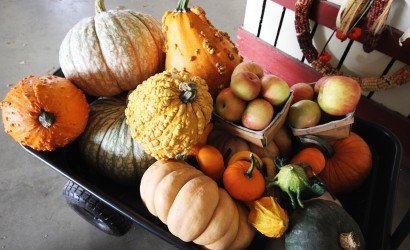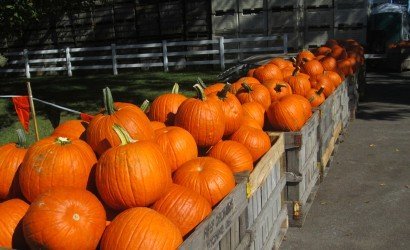A long white house rests on the land just as it has for nearly 300 years. Quite a few animals, a bumper crop of organic peppers, eggplants, fig trees, grapes, about 150 varieties of heirloom tomatoes…and two infamous ghosts, call the grounds home. That’s right—ghosts; although this story is much ado about the tomatoes.
White House Farm circa 1721, is the home of Dolly Baker a retired Biologist—also known by the moniker of The Tomato Lady, bestowed upon her by patrons of the Chestertown, MD Farmer’s Market, where Baker can be found from April through September. Baker once ran a Biology Lab for Anne Arundel County Public Schools, worked as a Botanical Illustrator—which means she can draw tiny organisms most of us don’t even know exist, among other things — and has grown plants for a number of organizations including the University of Maryland and the Smithsonian. In 2000, Baker was looking for a change.
“I’m into genealogy and was over here [near Chestertown, from Annapolis] looking for old farms that were in my mother’s family. We looked at the Perkin’s Farm, which was the oldest, and the owner told me she wanted to sell.”
|
White House Farm, on the National Register of Historic Places, is the ancestral home of the Perkin’s family, who count a famous Revolutionary War hero and apparently, two ghosts, as their more famous descendants. The farm had been out of the family for about 150 years until Baker took ownership—a change that seems to sit well with the restless inhabitants. “I’ve heard that they [the ghosts] bothered everybody else. I think they were happy to have the farm back in the family.” For those who may not be familiar, the White House Farm is known for it’s “bleeding rock.” As the most famous tale goes, a young woman named Mary who lived at the house, planned to elope. She climbed out of her bedroom window one January in the early 1800’s, and rode her horse to the end of the lane where it bucked her off. She hit her head on a large rock, meeting her demise. The bloodstains are said to return to the rock no matter how many times the owners throughout the centuries have tried to wash them away. |
.JPG)
|
|
The ghost stories are part of local folklore, and as Baker says, “are good for publicity,” but these days the farm’s focus is on the 150 varieties of Heirloom tomatoes Baker cultivates from her kitchen table. She likely grows more varieties of organic heirlooms than anybody else in Maryland, and she doesn’t have a greenhouse—giving new meaning to the term kitchen table entrepreneur. From Biologist to Tomato Grower How does one transition from Biologist to The Tomato Lady? In her own eating habits, Baker has always tried to avoid food with chemicals. Her interest in tomatoes themselves stem back about 25 years—to a trip she took to the William Paca House and Gardens in Annapolis, encountering her first Yellow Pear cherry tomato. Making the variety even more intriguing to Baker—the William Paca gardens only grew plants originating from the 1700’s. Baker’s interest in Heirloom tomatoes—took seed; pun intentional. |
 |
|
By Baker’s own definition, she is a “seed saver.” All 150 varieties of her plants come from seeds she has taken from actual tomatoes she grew (the Heirlooms are self-pollinating)—many coming from plant strains that are 100 years old, or more. One of Baker’s varieties, the Purple Calabash, was also grown on Thomas Jefferson’s Monticello in the late 1700’s. Baker’s stock has grown from about 10 varieties just starting out a quarter century ago, to the more than 150 varieties, now. She meticulously catalogues them, choosing to store them in airtight film or pharmacy containers, ensuring that her customers receive the type of plant they intend. Baker says she is, “really good at tedious little inane things,” indicating the time and patience she devotes to her tomatoes. But, aside from what her personality may naturally lend itself to, Baker’s interest in tomatoes likely has a predisposed genetic component. She is a 5th generation member of the Baker family, who owned canneries on the Eastern Shore, and invented the process of sealing the cans without lead. Their main products were tomatoes and corn. |
 |
|
Baker has been on a quest of sorts to identify what type of tomato would have found it’s way into these early cans—in essence, identify the grandfather to the Eastern Shore tomato. It had to have thrived and produced in mass quantities to supply the demand needed by the canneries. Baker has narrowed it down, and is leaning towards Brandywine, Red Ponderosa, or Rutgers, and she knows the Beefsteak was often used—all varieties she grows, and sells the seeds to. Buying the Seeds to History White House Farm is privately held, and isn’t open to the public. But, Baker sells about 120 varieties of Heirlooms on her website. She ships all over the country, and sells year-round, in keeping with the various growing seasons. For Eastern Shore residents, it’s now time to plant the seeds (indoors initially), to germinate and grow into the seedlings that will eventually be transplanted outdoors after the danger of frost has subsided, (around the first week of May). For those who may be new to growing heirlooms, Baker has the following recommendations: |
 |
- Certain varieties will do better based on where they will eventually be grown—in pots, raised beds, traditional in-ground gardens.
- She recommends a mixture based on maturity. 50-55 days to produce are considered early. Choose a few early cherry varieties, and eat them in salads while waiting for the Beefsteak to grow and ripen, for example.
- Pink varieties are generally a lot sweeter than red.
- The more popular types are:
- Brandywine, Sweet 100, Yellow Pear (as mentioned previously, from the 1700’s), Cherokee Purple, Romas, Jersey “Rutgers”, Green Zebra (a hybrid cherry), Black Cherry, Black Prince, Purple Calabash—the Monticello variety, and Red Rocket.
For those who aren’t accustomed to growing plants from seed, Baker will begin appearing at the Chestertown, MD Farmer’s Market in April with her seedlings, and later on with actual tomatoes, peppers, eggplants, and figs.
If you would like to try your hand at growing something new, Baker sells her Heirlooms in packages of 15. Orders can be placed now through her website, and she does answer customer questions by phone. The plants tend to do well as they have a history with, and are accustomed to Maryland soil.
For your $2.00 per package, you will be receiving a part of history, grown on one of the Eastern Shore’s earliest, still operational farms. It’s important to note, the seeds convey with purchase—the ghosts do not.
For more information:
White House Farm by phone: 410.348.5554; please note the website for ordering, (below) is fully operational and is currently accepting orders although the year is listed as 2011.
All Photographs courtesy of White House Farm.









